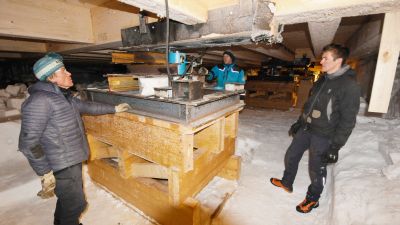
Final Week of the Season at the Princess Elisabeth Antarctica
The 2021-2022 BELARE season seems to have passed very quickly! After the departure of the last teams of scientists on February 4th, the rest of the IPF team has been doing everything necessary to prepare the Princess Elisabeth Antarctica for overwintering.
As the last thirteen members of the team left at the station for the last weeks of the season, we’ve been so busy! Before leaving the IPF team needs to do maintenance on the different systems of the station and ensuring the continuation of data collection for scientific projects until the last flight back to Cape Town at the beginning of next week.
During these last few days, one of the most important tasks has been preparing the electrical systems of the station to switch to winter mode. In this mode, the station’s energy use priorities are adapted for the austral winter months when the station will run autonomously. Engineers and technicians are busy preparing and testing the station’s energy production systems, as well as making all necessary adjustments on the Programmable Logic Controller (PLC, the station's electronic “brain”), which runs all the equipment in the station and makes sure everything goes smoothly during the eight months that the station is unoccupied.
Some scientific equipment only collects data during the austral summer research season, so we must dismantle and carefully pack it away to be shipped back to scientists in Europe. However, many instruments will continue to collect data during the austral winter. Making sure power continues to feed this equipment is essential for the scientific projects that collect data all year round.
Draining and cleaning the water treatment system is another ritual we need to do at the end of the season. First, all the toilets will be closed (leaving the dry toilets as the last option). Then the washing machine and dryer will be shut off. Finally, on the last day of the season, we’ll close the showers and the water distribution to the kitchen.
As the station’s annexes sit on top of a slowly moving glacier, the team needs to lift and adjust the level of the building twice a year to compensate for the glacier’s natural retreat. One side of the construction is attached to the granite ridge the station states upon with hinges, while the other can be lifted upwards thanks to a series of hydraulic pumps. This allows us to install an additional layer of about 6 cm between the annexes’ beams and the thirteen supports on which they sit.
Finally all the vehicles, storage containers and field equipment (cabooses and mobile laboratories) need to be properly stored. This means moving them from the flat “terrace” on front of the station to the Winter Park blue ice field and hangar located about 3.5 km away from the station.
For the team leaving to Cape Town early next week (the exact date will depend on weather conditions), it will of course be nice to return home to see our families and friends again after several months on the ice. But at the same time, many of us will miss the unique and spectacular environment that surrounds the Princess Elisabeth Antarctica.
Picture: Expedition Leader Alain Hubert and a team of carpenters and engineers from IPF raise the annexes of the Princess Elisabeth Antarctica research station due to movement of the glacier its sits upon - © International Polar Foundation
